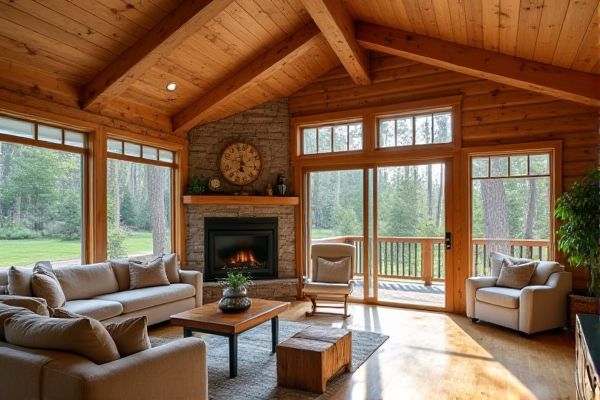
Cedar ceilings offer natural resistance to moisture and insects, making them ideal for humid environments, while pine ceilings provide a more budget-friendly option with a lighter, versatile appearance that can be easily stained or painted. Discover how choosing between cedar and pine can influence the durability, aesthetics, and maintenance of Your ceiling by reading the rest of the article.
Table of Comparison
| Feature | Cedar Ceiling | Pine Ceiling |
|---|---|---|
| Durability | High resistance to rot and insects | Moderate, less resistant to decay |
| Appearance | Rich reddish tones with natural aroma | Light color, smooth grain, versatile |
| Maintenance | Low, naturally weather-resistant | Requires regular sealing or painting |
| Cost | Higher price per board foot | More affordable and widely available |
| Installation | Easy to install, stable wood | Easy to install but prone to warping |
| Environmental Impact | Sustainably sourced options available | Fast-growing, sustainable choice |
Introduction: Cedar Ceiling vs Pine Ceiling
Cedar ceilings offer natural resistance to moisture, decay, and insects, making them ideal for humid or high-traffic areas, while pine ceilings stand out for their affordability and ease of customization with stains and paints. The rich, reddish tones of cedar provide a warm, elegant aesthetic, contrasting with pine's lighter, more neutral hues that brighten spaces and complement various design styles. Your choice between cedar and pine ceilings will depend on factors like durability, maintenance, budget, and the desired look and feel of your interior.
Aesthetic Differences: Cedar vs Pine
Cedar ceilings showcase rich reddish-brown tones with natural knots and a smooth, fine grain that enhances rustic and elegant interior designs. Pine ceilings offer lighter, creamy hues with more pronounced knots and a varied grain pattern, lending a cozy and traditional feel to spaces. The choice between cedar and pine ceilings impacts room ambiance through their distinct color palettes and texture characteristics.
Durability and Lifespan Comparison
Cedar ceilings offer greater durability and resistance to moisture, decay, and insect damage compared to pine, making them ideal for long-lasting indoor and outdoor applications. Pine ceilings, while more affordable, have a shorter lifespan due to their softer wood composition, which makes them more prone to dents, scratches, and environmental wear. Cedar can last over 30 years with proper maintenance, whereas pine typically lasts around 10 to 15 years before showing significant signs of aging.
Cost Analysis: Cedar Ceiling vs Pine Ceiling
Cedar ceiling installations typically cost between $7 to $10 per square foot, reflecting its durability and natural resistance to moisture and insects. Pine ceilings are more budget-friendly, averaging $3 to $6 per square foot, but may require more maintenance and treatment to prevent warping or pest damage. Homeowners should weigh the initial higher investment in cedar against potential long-term savings on repairs and upkeep associated with pine.
Maintenance Requirements
Cedar ceilings require less maintenance due to their natural resistance to moisture, insects, and decay, making them ideal for long-term durability in humid environments. Pine ceilings, while more affordable, often need regular sealing and treatment to prevent warping, cracking, and pest damage. You can reduce upkeep efforts with cedar by opting for this wood when low maintenance is a priority in your interior design.
Moisture and Rot Resistance
Cedar ceilings offer superior moisture and rot resistance compared to pine, making them ideal for areas with high humidity or potential water exposure. Cedar contains natural oils and tannins that act as preservatives, preventing decay and insect damage, while pine is more susceptible to moisture-related issues unless properly treated. Choosing a cedar ceiling ensures your space remains durable and visually appealing with minimal maintenance over time.
Insulation and Acoustic Properties
Cedar ceilings offer superior insulation due to their natural oils and dense grain, which help regulate indoor temperature and reduce energy costs. Pine ceilings, while more affordable, provide moderate insulation but are less effective in sound absorption compared to cedar's ability to dampen noise and improve room acoustics. Choosing cedar can enhance your space by combining both thermal insulation and acoustic comfort.
Sustainability and Environmental Impact
Cedar ceilings are highly sustainable due to cedar's natural resistance to decay, which reduces the need for chemical treatments and extends the wood's lifespan, lowering environmental impact. Pine ceilings, while more abundant and faster-growing, often require more frequent replacement and chemical preservatives, contributing to higher carbon footprints over time. Choosing FSC-certified cedar or pine ensures responsible forest management and enhances overall environmental sustainability.
Best Applications for Cedar and Pine Ceilings
Cedar ceilings excel in moisture-prone areas like bathrooms and kitchens due to their natural resistance to rot and insects, making them ideal for environments requiring durability and longevity. Pine ceilings are best suited for living rooms or bedrooms where affordability and a warm, rustic aesthetic are desired, as pine offers easy customization through staining or painting. Your choice should consider cedar for resilience in humid spaces, while pine enhances cozy, budget-friendly interiors.
Final Verdict: Choosing the Right Ceiling Material
Cedar ceilings offer natural resistance to moisture, insects, and decay, making them ideal for long-lasting durability and a rich, aromatic finish. Pine ceilings provide a cost-effective alternative with a lighter color and uniform grain, perfect for a bright, rustic aesthetic. Your choice depends on balancing budget with durability needs and desired visual appeal, where cedar excels in longevity and pine suits lighter, more affordable interior designs.
 homyna.com
homyna.com